Critical Analysis: Marketing & Management for Sustainability Linkages
VerifiedAdded on 2021/02/20
|10
|2473
|24
Report
AI Summary
This report critically analyzes the linkages between marketing and management within the context of sustainability and the circular economy. It begins by defining the circular economy and its focus on reusing, repairing, recycling, and reprocessing resources to minimize waste and pollution. The report examines how various companies, including Burberry, H&M Group, Adidas, Primark, Aditya Birla, and Nanushka, are implementing circular economy principles in their resource management strategies. It details the issues of resource utilization and the approaches these businesses are taking to address them. The report then explores fundamental circular economy strategies such as narrowing, slowing, and closing loops, explaining how each contributes to resource efficiency and product life extension. Finally, the report discusses value dimensions, including value propositions, value creation and delivery, and value capture, and how they influence consumer loyalty and efficient resource utilization. Overall, the report provides insights into the practical application of circular economy principles in the ready-made garments industry and the role of marketing and management in achieving sustainable business practices.
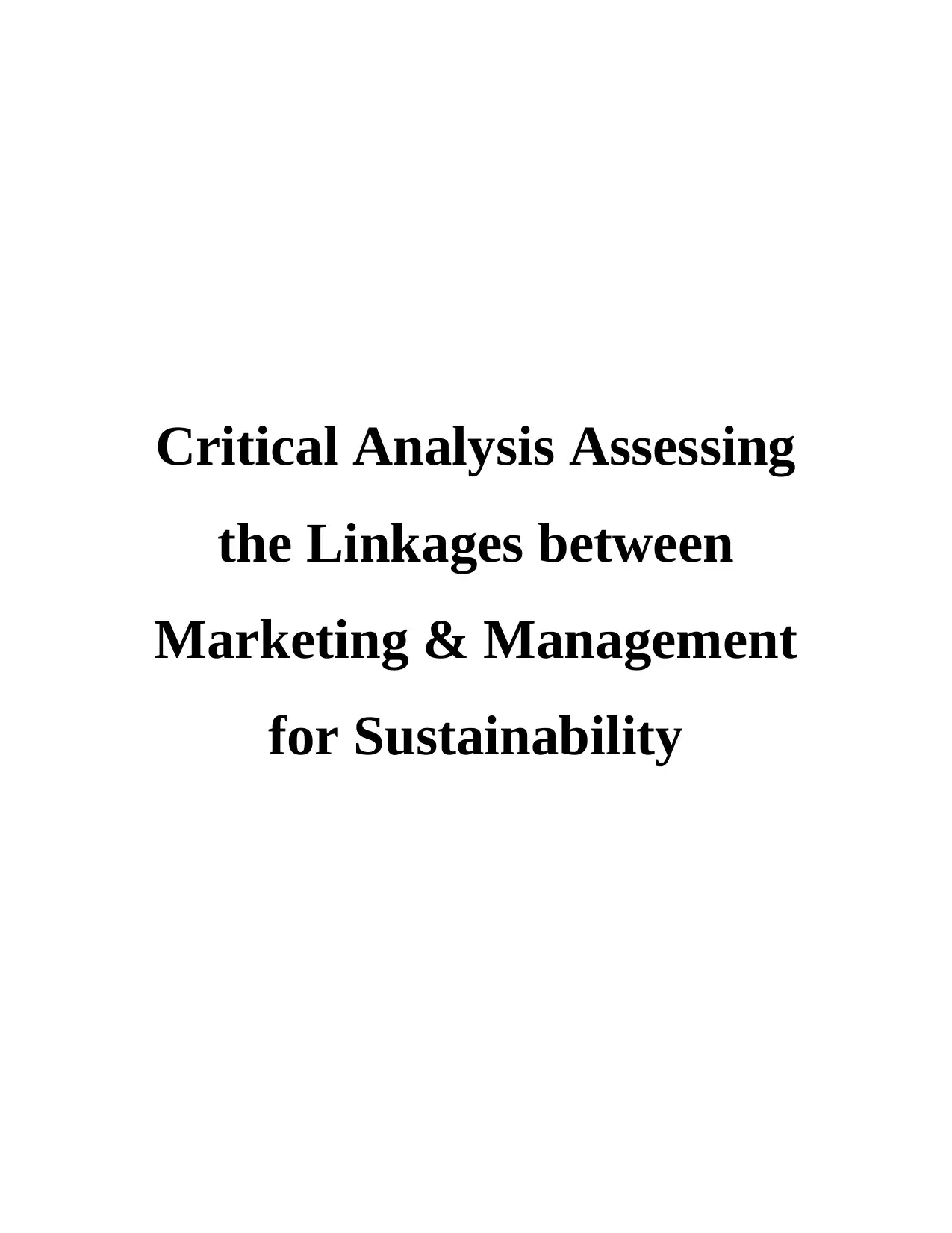
Critical Analysis Assessing
the Linkages between
Marketing & Management
for Sustainability
the Linkages between
Marketing & Management
for Sustainability
Paraphrase This Document
Need a fresh take? Get an instant paraphrase of this document with our AI Paraphraser
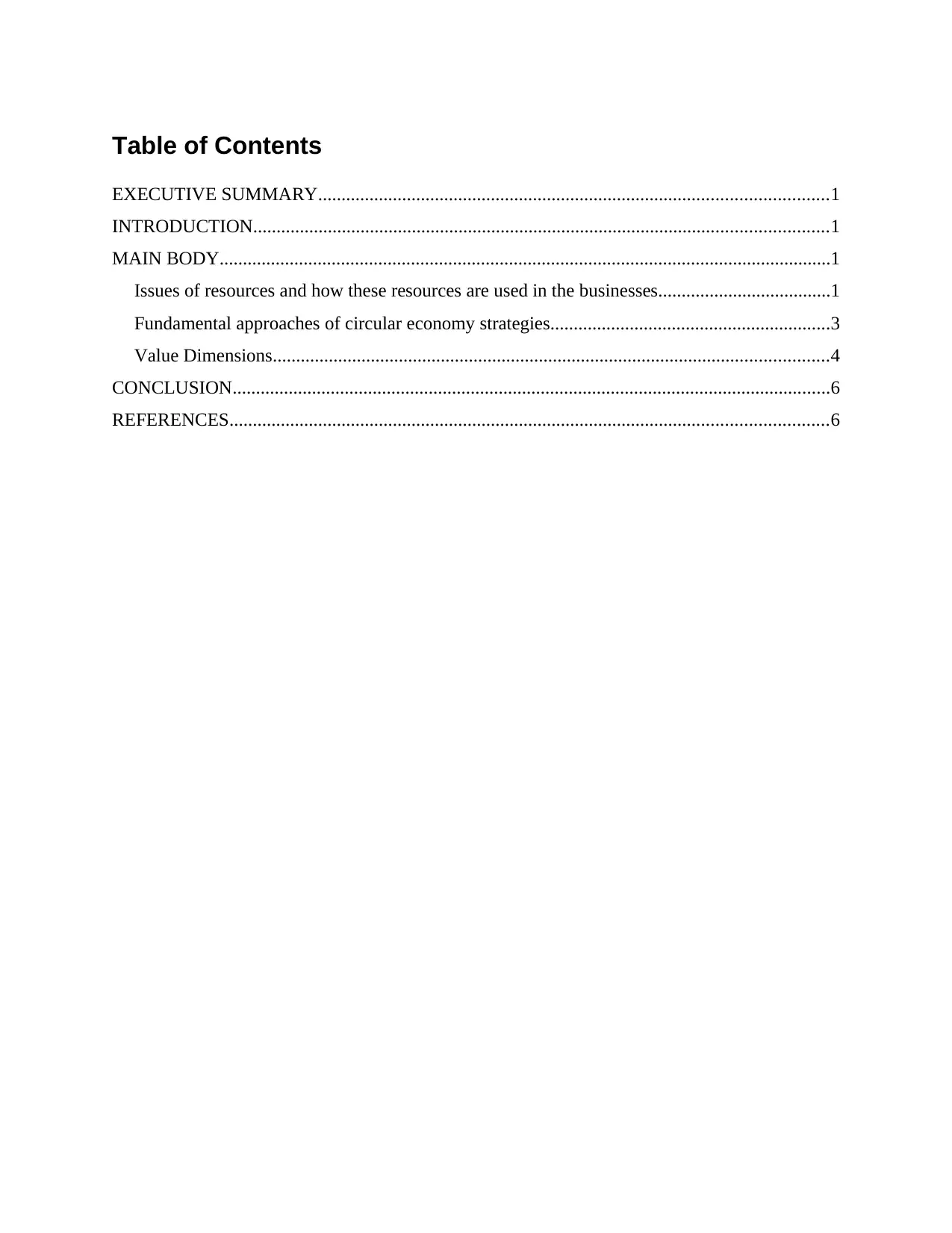
Table of Contents
EXECUTIVE SUMMARY.............................................................................................................1
INTRODUCTION...........................................................................................................................1
MAIN BODY...................................................................................................................................1
Issues of resources and how these resources are used in the businesses.....................................1
Fundamental approaches of circular economy strategies............................................................3
Value Dimensions.......................................................................................................................4
CONCLUSION................................................................................................................................6
REFERENCES................................................................................................................................6
EXECUTIVE SUMMARY.............................................................................................................1
INTRODUCTION...........................................................................................................................1
MAIN BODY...................................................................................................................................1
Issues of resources and how these resources are used in the businesses.....................................1
Fundamental approaches of circular economy strategies............................................................3
Value Dimensions.......................................................................................................................4
CONCLUSION................................................................................................................................6
REFERENCES................................................................................................................................6
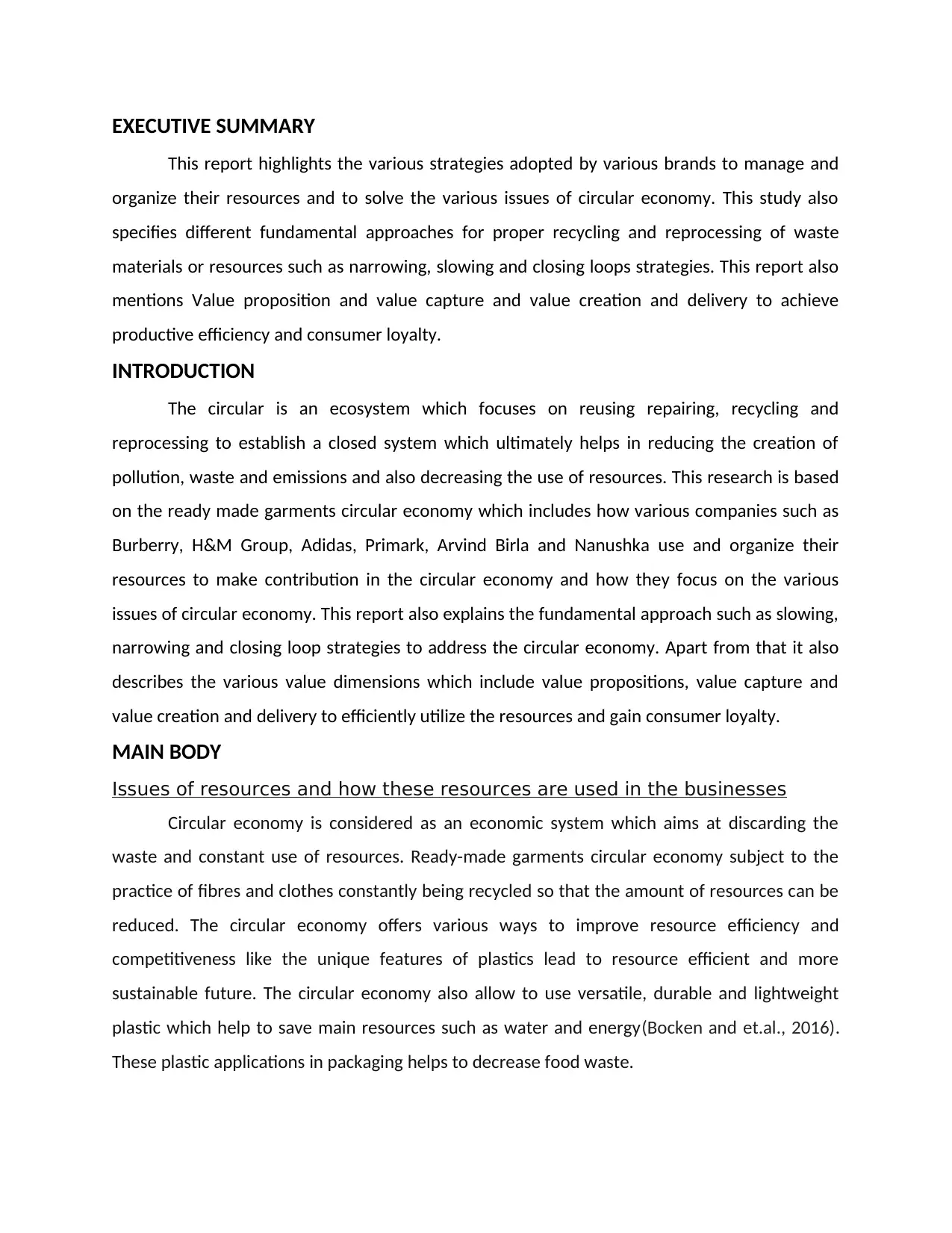
EXECUTIVE SUMMARY
This report highlights the various strategies adopted by various brands to manage and
organize their resources and to solve the various issues of circular economy. This study also
specifies different fundamental approaches for proper recycling and reprocessing of waste
materials or resources such as narrowing, slowing and closing loops strategies. This report also
mentions Value proposition and value capture and value creation and delivery to achieve
productive efficiency and consumer loyalty.
INTRODUCTION
The circular is an ecosystem which focuses on reusing repairing, recycling and
reprocessing to establish a closed system which ultimately helps in reducing the creation of
pollution, waste and emissions and also decreasing the use of resources. This research is based
on the ready made garments circular economy which includes how various companies such as
Burberry, H&M Group, Adidas, Primark, Arvind Birla and Nanushka use and organize their
resources to make contribution in the circular economy and how they focus on the various
issues of circular economy. This report also explains the fundamental approach such as slowing,
narrowing and closing loop strategies to address the circular economy. Apart from that it also
describes the various value dimensions which include value propositions, value capture and
value creation and delivery to efficiently utilize the resources and gain consumer loyalty.
MAIN BODY
Issues of resources and how these resources are used in the businesses
Circular economy is considered as an economic system which aims at discarding the
waste and constant use of resources. Ready-made garments circular economy subject to the
practice of fibres and clothes constantly being recycled so that the amount of resources can be
reduced. The circular economy offers various ways to improve resource efficiency and
competitiveness like the unique features of plastics lead to resource efficient and more
sustainable future. The circular economy also allow to use versatile, durable and lightweight
plastic which help to save main resources such as water and energy(Bocken and et.al., 2016).
These plastic applications in packaging helps to decrease food waste.
This report highlights the various strategies adopted by various brands to manage and
organize their resources and to solve the various issues of circular economy. This study also
specifies different fundamental approaches for proper recycling and reprocessing of waste
materials or resources such as narrowing, slowing and closing loops strategies. This report also
mentions Value proposition and value capture and value creation and delivery to achieve
productive efficiency and consumer loyalty.
INTRODUCTION
The circular is an ecosystem which focuses on reusing repairing, recycling and
reprocessing to establish a closed system which ultimately helps in reducing the creation of
pollution, waste and emissions and also decreasing the use of resources. This research is based
on the ready made garments circular economy which includes how various companies such as
Burberry, H&M Group, Adidas, Primark, Arvind Birla and Nanushka use and organize their
resources to make contribution in the circular economy and how they focus on the various
issues of circular economy. This report also explains the fundamental approach such as slowing,
narrowing and closing loop strategies to address the circular economy. Apart from that it also
describes the various value dimensions which include value propositions, value capture and
value creation and delivery to efficiently utilize the resources and gain consumer loyalty.
MAIN BODY
Issues of resources and how these resources are used in the businesses
Circular economy is considered as an economic system which aims at discarding the
waste and constant use of resources. Ready-made garments circular economy subject to the
practice of fibres and clothes constantly being recycled so that the amount of resources can be
reduced. The circular economy offers various ways to improve resource efficiency and
competitiveness like the unique features of plastics lead to resource efficient and more
sustainable future. The circular economy also allow to use versatile, durable and lightweight
plastic which help to save main resources such as water and energy(Bocken and et.al., 2016).
These plastic applications in packaging helps to decrease food waste.
⊘ This is a preview!⊘
Do you want full access?
Subscribe today to unlock all pages.

Trusted by 1+ million students worldwide
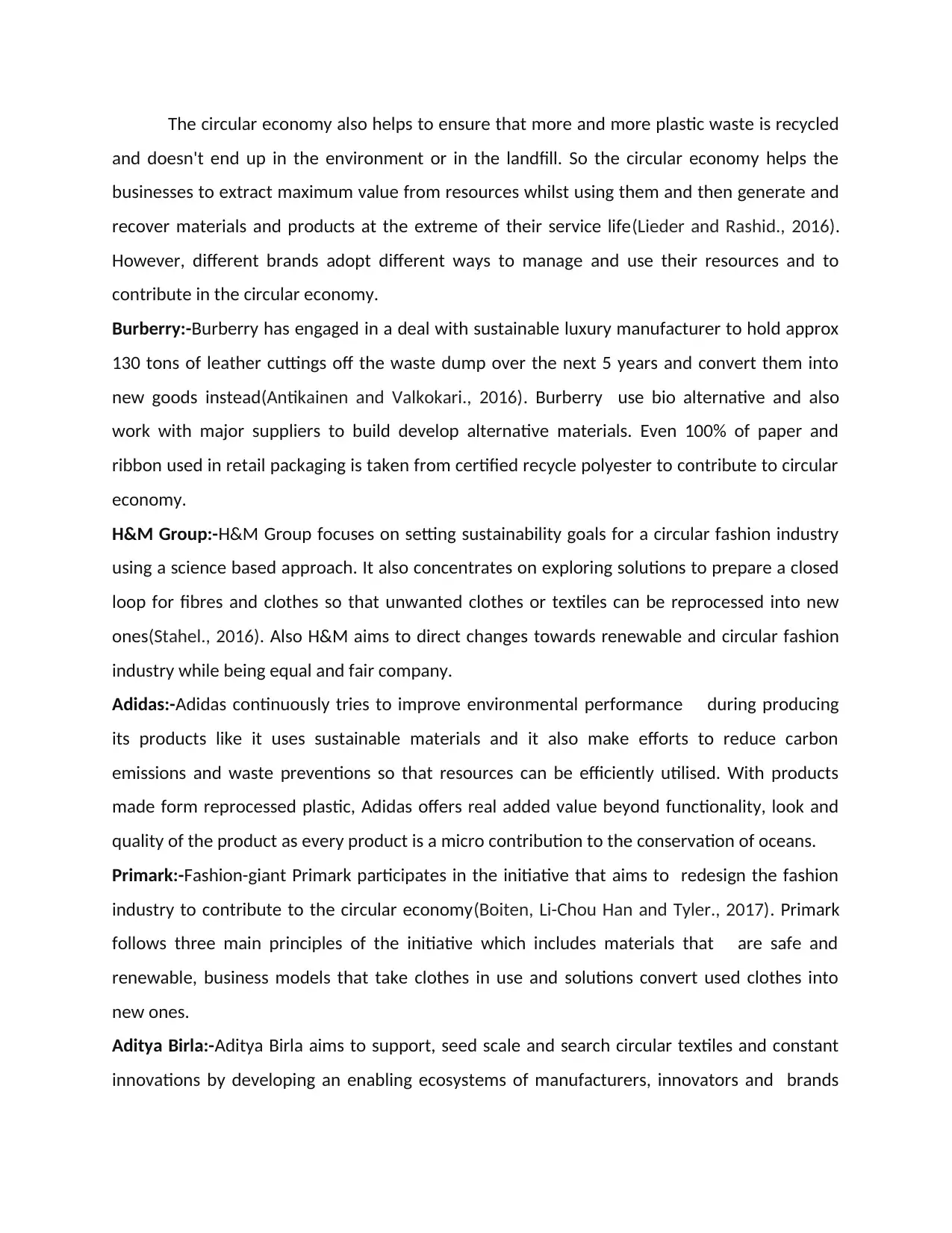
The circular economy also helps to ensure that more and more plastic waste is recycled
and doesn't end up in the environment or in the landfill. So the circular economy helps the
businesses to extract maximum value from resources whilst using them and then generate and
recover materials and products at the extreme of their service life(Lieder and Rashid., 2016).
However, different brands adopt different ways to manage and use their resources and to
contribute in the circular economy.
Burberry:-Burberry has engaged in a deal with sustainable luxury manufacturer to hold approx
130 tons of leather cuttings off the waste dump over the next 5 years and convert them into
new goods instead(Antikainen and Valkokari., 2016). Burberry use bio alternative and also
work with major suppliers to build develop alternative materials. Even 100% of paper and
ribbon used in retail packaging is taken from certified recycle polyester to contribute to circular
economy.
H&M Group:-H&M Group focuses on setting sustainability goals for a circular fashion industry
using a science based approach. It also concentrates on exploring solutions to prepare a closed
loop for fibres and clothes so that unwanted clothes or textiles can be reprocessed into new
ones(Stahel., 2016). Also H&M aims to direct changes towards renewable and circular fashion
industry while being equal and fair company.
Adidas:-Adidas continuously tries to improve environmental performance during producing
its products like it uses sustainable materials and it also make efforts to reduce carbon
emissions and waste preventions so that resources can be efficiently utilised. With products
made form reprocessed plastic, Adidas offers real added value beyond functionality, look and
quality of the product as every product is a micro contribution to the conservation of oceans.
Primark:-Fashion-giant Primark participates in the initiative that aims to redesign the fashion
industry to contribute to the circular economy(Boiten, Li-Chou Han and Tyler., 2017). Primark
follows three main principles of the initiative which includes materials that are safe and
renewable, business models that take clothes in use and solutions convert used clothes into
new ones.
Aditya Birla:-Aditya Birla aims to support, seed scale and search circular textiles and constant
innovations by developing an enabling ecosystems of manufacturers, innovators and brands
and doesn't end up in the environment or in the landfill. So the circular economy helps the
businesses to extract maximum value from resources whilst using them and then generate and
recover materials and products at the extreme of their service life(Lieder and Rashid., 2016).
However, different brands adopt different ways to manage and use their resources and to
contribute in the circular economy.
Burberry:-Burberry has engaged in a deal with sustainable luxury manufacturer to hold approx
130 tons of leather cuttings off the waste dump over the next 5 years and convert them into
new goods instead(Antikainen and Valkokari., 2016). Burberry use bio alternative and also
work with major suppliers to build develop alternative materials. Even 100% of paper and
ribbon used in retail packaging is taken from certified recycle polyester to contribute to circular
economy.
H&M Group:-H&M Group focuses on setting sustainability goals for a circular fashion industry
using a science based approach. It also concentrates on exploring solutions to prepare a closed
loop for fibres and clothes so that unwanted clothes or textiles can be reprocessed into new
ones(Stahel., 2016). Also H&M aims to direct changes towards renewable and circular fashion
industry while being equal and fair company.
Adidas:-Adidas continuously tries to improve environmental performance during producing
its products like it uses sustainable materials and it also make efforts to reduce carbon
emissions and waste preventions so that resources can be efficiently utilised. With products
made form reprocessed plastic, Adidas offers real added value beyond functionality, look and
quality of the product as every product is a micro contribution to the conservation of oceans.
Primark:-Fashion-giant Primark participates in the initiative that aims to redesign the fashion
industry to contribute to the circular economy(Boiten, Li-Chou Han and Tyler., 2017). Primark
follows three main principles of the initiative which includes materials that are safe and
renewable, business models that take clothes in use and solutions convert used clothes into
new ones.
Aditya Birla:-Aditya Birla aims to support, seed scale and search circular textiles and constant
innovations by developing an enabling ecosystems of manufacturers, innovators and brands
Paraphrase This Document
Need a fresh take? Get an instant paraphrase of this document with our AI Paraphraser
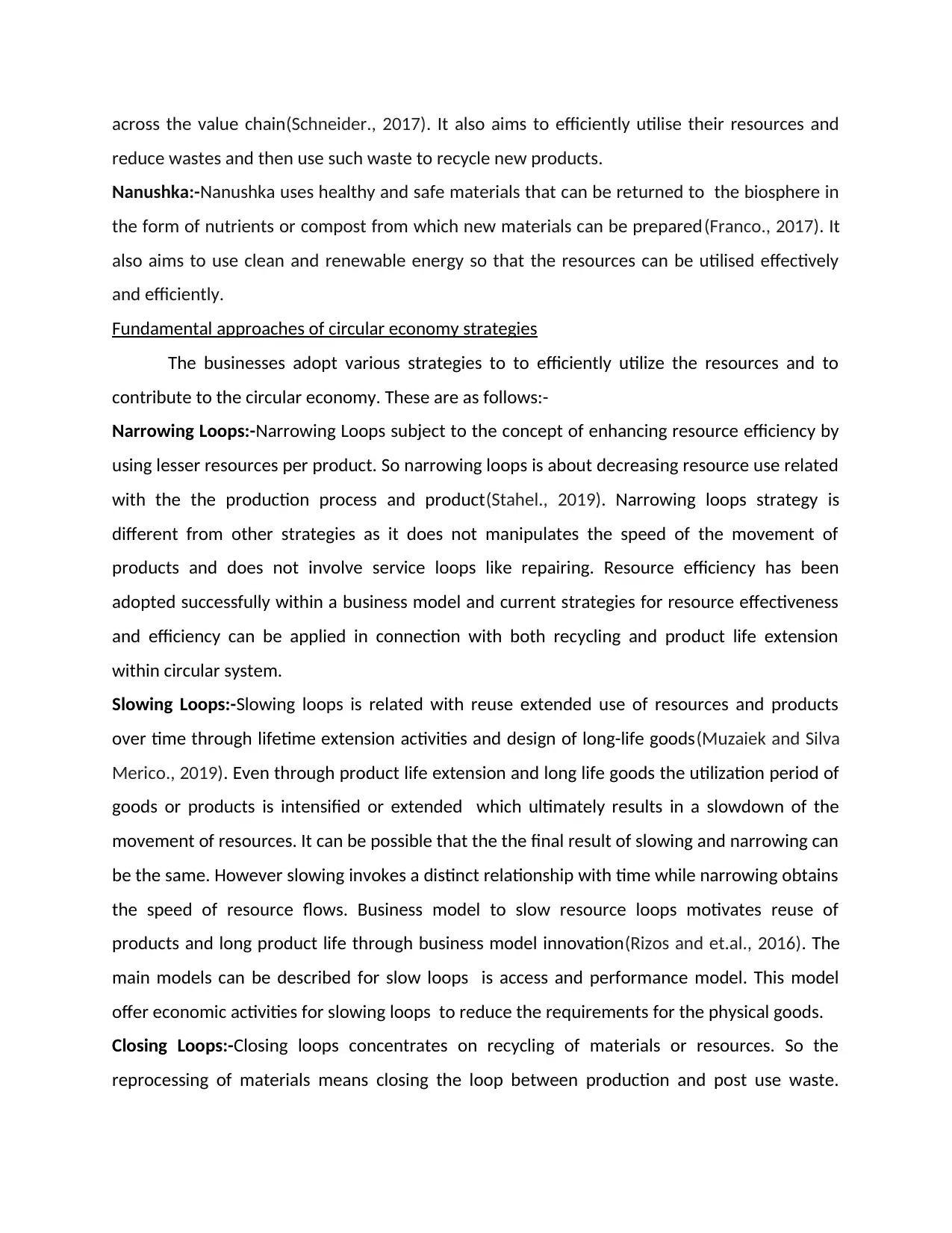
across the value chain(Schneider., 2017). It also aims to efficiently utilise their resources and
reduce wastes and then use such waste to recycle new products.
Nanushka:-Nanushka uses healthy and safe materials that can be returned to the biosphere in
the form of nutrients or compost from which new materials can be prepared(Franco., 2017). It
also aims to use clean and renewable energy so that the resources can be utilised effectively
and efficiently.
Fundamental approaches of circular economy strategies
The businesses adopt various strategies to to efficiently utilize the resources and to
contribute to the circular economy. These are as follows:-
Narrowing Loops:-Narrowing Loops subject to the concept of enhancing resource efficiency by
using lesser resources per product. So narrowing loops is about decreasing resource use related
with the the production process and product(Stahel., 2019). Narrowing loops strategy is
different from other strategies as it does not manipulates the speed of the movement of
products and does not involve service loops like repairing. Resource efficiency has been
adopted successfully within a business model and current strategies for resource effectiveness
and efficiency can be applied in connection with both recycling and product life extension
within circular system.
Slowing Loops:-Slowing loops is related with reuse extended use of resources and products
over time through lifetime extension activities and design of long-life goods(Muzaiek and Silva
Merico., 2019). Even through product life extension and long life goods the utilization period of
goods or products is intensified or extended which ultimately results in a slowdown of the
movement of resources. It can be possible that the the final result of slowing and narrowing can
be the same. However slowing invokes a distinct relationship with time while narrowing obtains
the speed of resource flows. Business model to slow resource loops motivates reuse of
products and long product life through business model innovation(Rizos and et.al., 2016). The
main models can be described for slow loops is access and performance model. This model
offer economic activities for slowing loops to reduce the requirements for the physical goods.
Closing Loops:-Closing loops concentrates on recycling of materials or resources. So the
reprocessing of materials means closing the loop between production and post use waste.
reduce wastes and then use such waste to recycle new products.
Nanushka:-Nanushka uses healthy and safe materials that can be returned to the biosphere in
the form of nutrients or compost from which new materials can be prepared(Franco., 2017). It
also aims to use clean and renewable energy so that the resources can be utilised effectively
and efficiently.
Fundamental approaches of circular economy strategies
The businesses adopt various strategies to to efficiently utilize the resources and to
contribute to the circular economy. These are as follows:-
Narrowing Loops:-Narrowing Loops subject to the concept of enhancing resource efficiency by
using lesser resources per product. So narrowing loops is about decreasing resource use related
with the the production process and product(Stahel., 2019). Narrowing loops strategy is
different from other strategies as it does not manipulates the speed of the movement of
products and does not involve service loops like repairing. Resource efficiency has been
adopted successfully within a business model and current strategies for resource effectiveness
and efficiency can be applied in connection with both recycling and product life extension
within circular system.
Slowing Loops:-Slowing loops is related with reuse extended use of resources and products
over time through lifetime extension activities and design of long-life goods(Muzaiek and Silva
Merico., 2019). Even through product life extension and long life goods the utilization period of
goods or products is intensified or extended which ultimately results in a slowdown of the
movement of resources. It can be possible that the the final result of slowing and narrowing can
be the same. However slowing invokes a distinct relationship with time while narrowing obtains
the speed of resource flows. Business model to slow resource loops motivates reuse of
products and long product life through business model innovation(Rizos and et.al., 2016). The
main models can be described for slow loops is access and performance model. This model
offer economic activities for slowing loops to reduce the requirements for the physical goods.
Closing Loops:-Closing loops concentrates on recycling of materials or resources. So the
reprocessing of materials means closing the loop between production and post use waste.
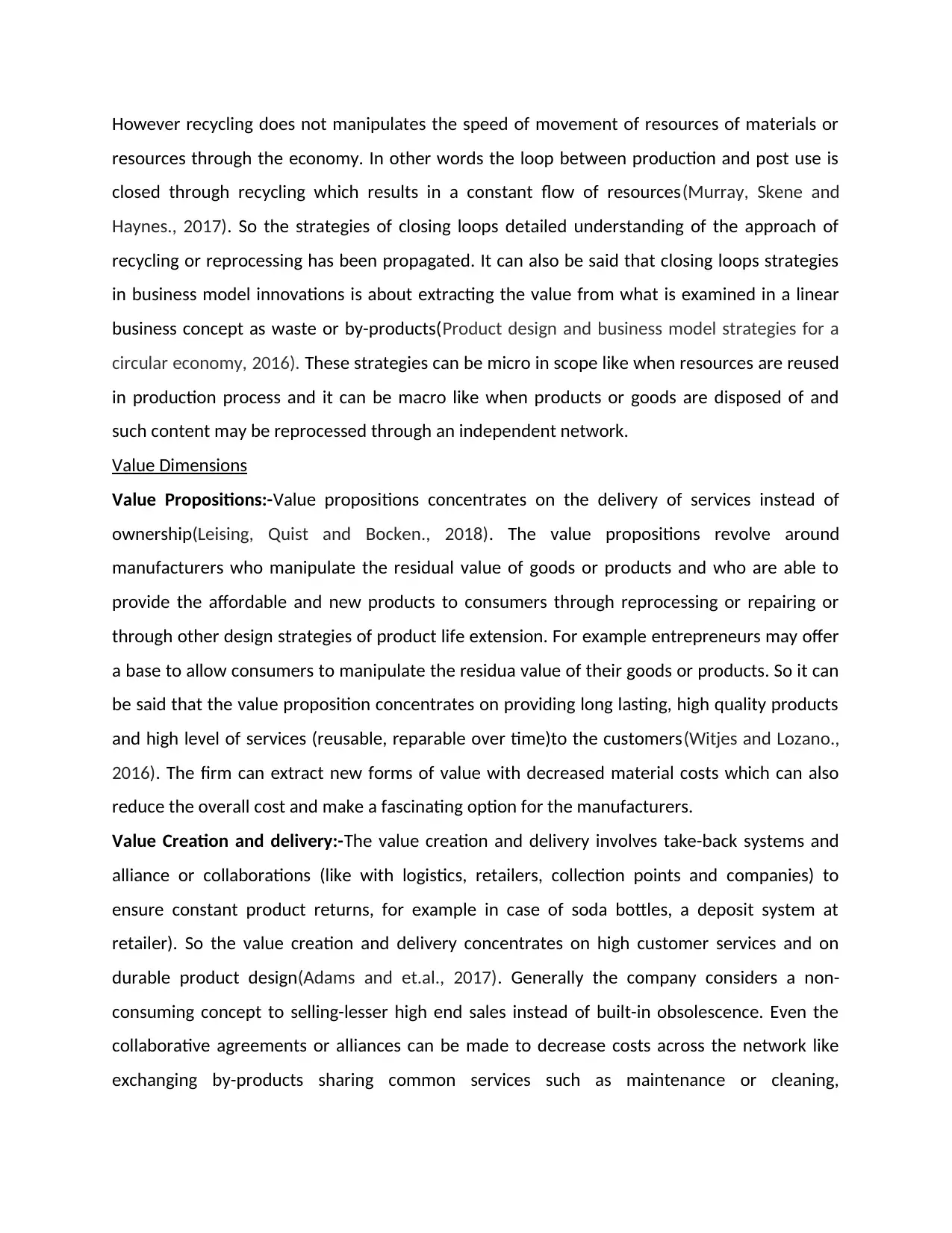
However recycling does not manipulates the speed of movement of resources of materials or
resources through the economy. In other words the loop between production and post use is
closed through recycling which results in a constant flow of resources(Murray, Skene and
Haynes., 2017). So the strategies of closing loops detailed understanding of the approach of
recycling or reprocessing has been propagated. It can also be said that closing loops strategies
in business model innovations is about extracting the value from what is examined in a linear
business concept as waste or by-products(Product design and business model strategies for a
circular economy, 2016). These strategies can be micro in scope like when resources are reused
in production process and it can be macro like when products or goods are disposed of and
such content may be reprocessed through an independent network.
Value Dimensions
Value Propositions:-Value propositions concentrates on the delivery of services instead of
ownership(Leising, Quist and Bocken., 2018). The value propositions revolve around
manufacturers who manipulate the residual value of goods or products and who are able to
provide the affordable and new products to consumers through reprocessing or repairing or
through other design strategies of product life extension. For example entrepreneurs may offer
a base to allow consumers to manipulate the residua value of their goods or products. So it can
be said that the value proposition concentrates on providing long lasting, high quality products
and high level of services (reusable, reparable over time)to the customers(Witjes and Lozano.,
2016). The firm can extract new forms of value with decreased material costs which can also
reduce the overall cost and make a fascinating option for the manufacturers.
Value Creation and delivery:-The value creation and delivery involves take-back systems and
alliance or collaborations (like with logistics, retailers, collection points and companies) to
ensure constant product returns, for example in case of soda bottles, a deposit system at
retailer). So the value creation and delivery concentrates on high customer services and on
durable product design(Adams and et.al., 2017). Generally the company considers a non-
consuming concept to selling-lesser high end sales instead of built-in obsolescence. Even the
collaborative agreements or alliances can be made to decrease costs across the network like
exchanging by-products sharing common services such as maintenance or cleaning,
resources through the economy. In other words the loop between production and post use is
closed through recycling which results in a constant flow of resources(Murray, Skene and
Haynes., 2017). So the strategies of closing loops detailed understanding of the approach of
recycling or reprocessing has been propagated. It can also be said that closing loops strategies
in business model innovations is about extracting the value from what is examined in a linear
business concept as waste or by-products(Product design and business model strategies for a
circular economy, 2016). These strategies can be micro in scope like when resources are reused
in production process and it can be macro like when products or goods are disposed of and
such content may be reprocessed through an independent network.
Value Dimensions
Value Propositions:-Value propositions concentrates on the delivery of services instead of
ownership(Leising, Quist and Bocken., 2018). The value propositions revolve around
manufacturers who manipulate the residual value of goods or products and who are able to
provide the affordable and new products to consumers through reprocessing or repairing or
through other design strategies of product life extension. For example entrepreneurs may offer
a base to allow consumers to manipulate the residua value of their goods or products. So it can
be said that the value proposition concentrates on providing long lasting, high quality products
and high level of services (reusable, reparable over time)to the customers(Witjes and Lozano.,
2016). The firm can extract new forms of value with decreased material costs which can also
reduce the overall cost and make a fascinating option for the manufacturers.
Value Creation and delivery:-The value creation and delivery involves take-back systems and
alliance or collaborations (like with logistics, retailers, collection points and companies) to
ensure constant product returns, for example in case of soda bottles, a deposit system at
retailer). So the value creation and delivery concentrates on high customer services and on
durable product design(Adams and et.al., 2017). Generally the company considers a non-
consuming concept to selling-lesser high end sales instead of built-in obsolescence. Even the
collaborative agreements or alliances can be made to decrease costs across the network like
exchanging by-products sharing common services such as maintenance or cleaning,
⊘ This is a preview!⊘
Do you want full access?
Subscribe today to unlock all pages.

Trusted by 1+ million students worldwide
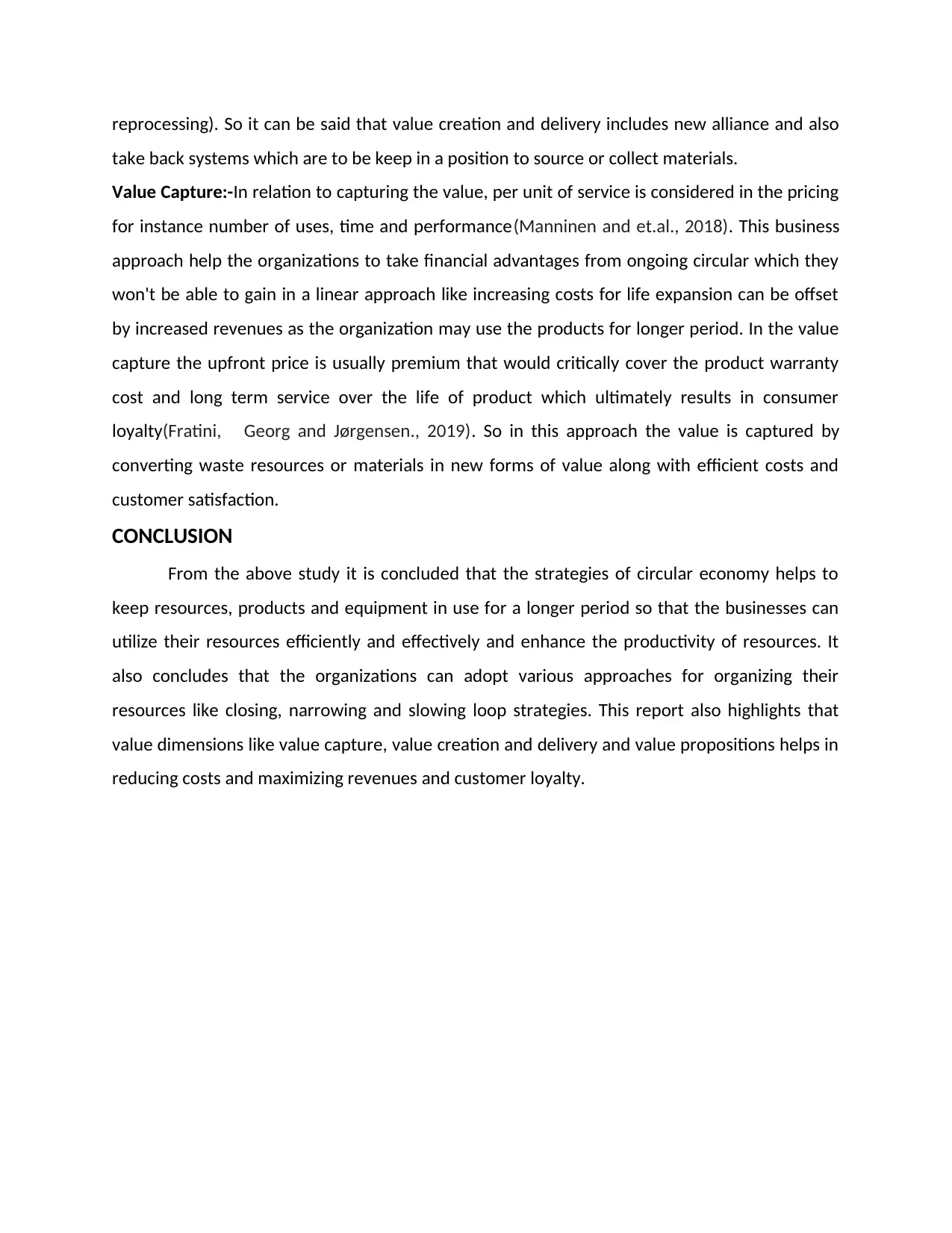
reprocessing). So it can be said that value creation and delivery includes new alliance and also
take back systems which are to be keep in a position to source or collect materials.
Value Capture:-In relation to capturing the value, per unit of service is considered in the pricing
for instance number of uses, time and performance(Manninen and et.al., 2018). This business
approach help the organizations to take financial advantages from ongoing circular which they
won't be able to gain in a linear approach like increasing costs for life expansion can be offset
by increased revenues as the organization may use the products for longer period. In the value
capture the upfront price is usually premium that would critically cover the product warranty
cost and long term service over the life of product which ultimately results in consumer
loyalty(Fratini, Georg and Jørgensen., 2019). So in this approach the value is captured by
converting waste resources or materials in new forms of value along with efficient costs and
customer satisfaction.
CONCLUSION
From the above study it is concluded that the strategies of circular economy helps to
keep resources, products and equipment in use for a longer period so that the businesses can
utilize their resources efficiently and effectively and enhance the productivity of resources. It
also concludes that the organizations can adopt various approaches for organizing their
resources like closing, narrowing and slowing loop strategies. This report also highlights that
value dimensions like value capture, value creation and delivery and value propositions helps in
reducing costs and maximizing revenues and customer loyalty.
take back systems which are to be keep in a position to source or collect materials.
Value Capture:-In relation to capturing the value, per unit of service is considered in the pricing
for instance number of uses, time and performance(Manninen and et.al., 2018). This business
approach help the organizations to take financial advantages from ongoing circular which they
won't be able to gain in a linear approach like increasing costs for life expansion can be offset
by increased revenues as the organization may use the products for longer period. In the value
capture the upfront price is usually premium that would critically cover the product warranty
cost and long term service over the life of product which ultimately results in consumer
loyalty(Fratini, Georg and Jørgensen., 2019). So in this approach the value is captured by
converting waste resources or materials in new forms of value along with efficient costs and
customer satisfaction.
CONCLUSION
From the above study it is concluded that the strategies of circular economy helps to
keep resources, products and equipment in use for a longer period so that the businesses can
utilize their resources efficiently and effectively and enhance the productivity of resources. It
also concludes that the organizations can adopt various approaches for organizing their
resources like closing, narrowing and slowing loop strategies. This report also highlights that
value dimensions like value capture, value creation and delivery and value propositions helps in
reducing costs and maximizing revenues and customer loyalty.
Paraphrase This Document
Need a fresh take? Get an instant paraphrase of this document with our AI Paraphraser
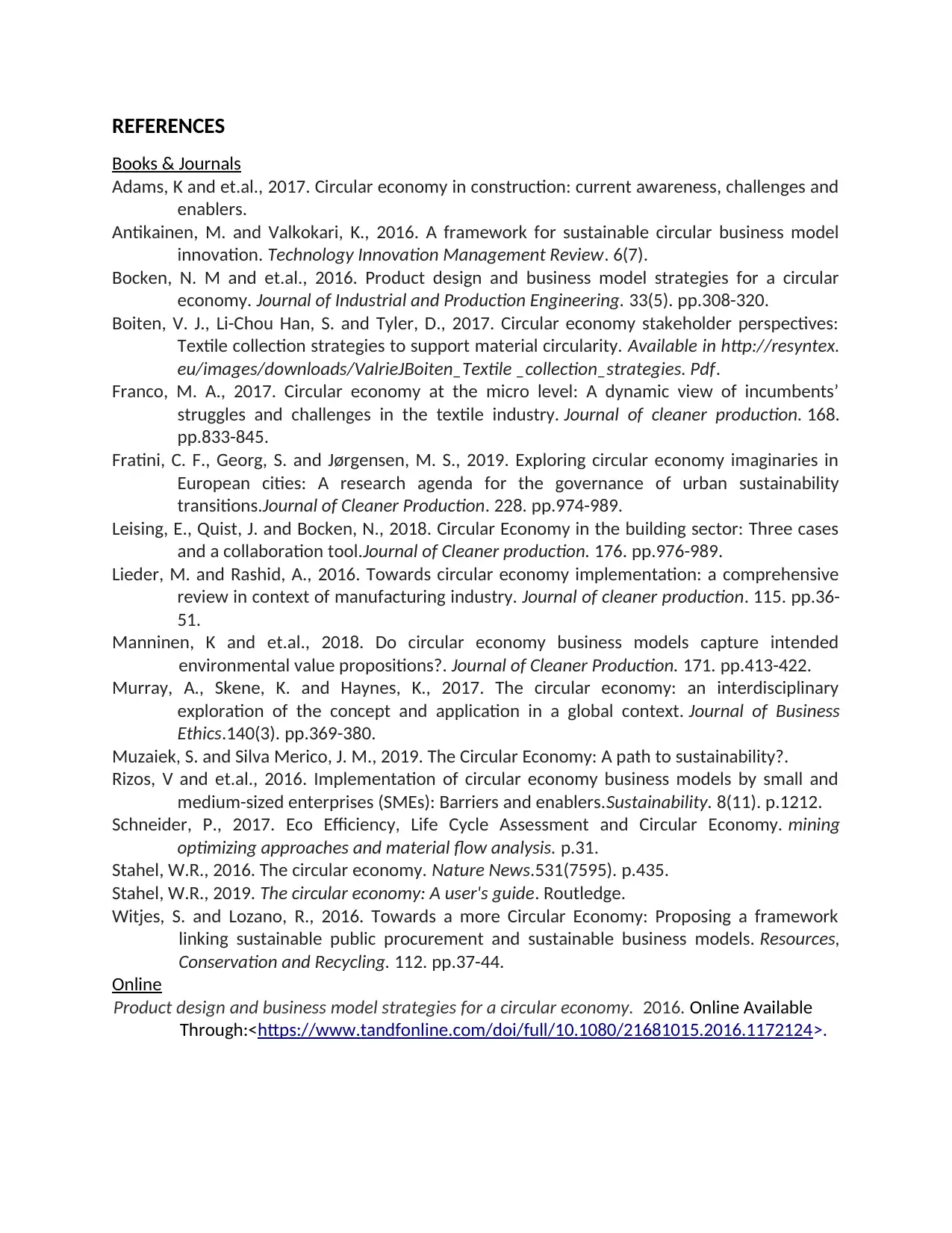
REFERENCES
Books & Journals
Adams, K and et.al., 2017. Circular economy in construction: current awareness, challenges and
enablers.
Antikainen, M. and Valkokari, K., 2016. A framework for sustainable circular business model
innovation. Technology Innovation Management Review. 6(7).
Bocken, N. M and et.al., 2016. Product design and business model strategies for a circular
economy. Journal of Industrial and Production Engineering. 33(5). pp.308-320.
Boiten, V. J., Li-Chou Han, S. and Tyler, D., 2017. Circular economy stakeholder perspectives:
Textile collection strategies to support material circularity. Available in http://resyntex.
eu/images/downloads/ValrieJBoiten_Textile _collection_strategies. Pdf.
Franco, M. A., 2017. Circular economy at the micro level: A dynamic view of incumbents’
struggles and challenges in the textile industry. Journal of cleaner production. 168.
pp.833-845.
Fratini, C. F., Georg, S. and Jørgensen, M. S., 2019. Exploring circular economy imaginaries in
European cities: A research agenda for the governance of urban sustainability
transitions.Journal of Cleaner Production. 228. pp.974-989.
Leising, E., Quist, J. and Bocken, N., 2018. Circular Economy in the building sector: Three cases
and a collaboration tool.Journal of Cleaner production. 176. pp.976-989.
Lieder, M. and Rashid, A., 2016. Towards circular economy implementation: a comprehensive
review in context of manufacturing industry. Journal of cleaner production. 115. pp.36-
51.
Manninen, K and et.al., 2018. Do circular economy business models capture intended
environmental value propositions?. Journal of Cleaner Production. 171. pp.413-422.
Murray, A., Skene, K. and Haynes, K., 2017. The circular economy: an interdisciplinary
exploration of the concept and application in a global context. Journal of Business
Ethics.140(3). pp.369-380.
Muzaiek, S. and Silva Merico, J. M., 2019. The Circular Economy: A path to sustainability?.
Rizos, V and et.al., 2016. Implementation of circular economy business models by small and
medium-sized enterprises (SMEs): Barriers and enablers.Sustainability. 8(11). p.1212.
Schneider, P., 2017. Eco Efficiency, Life Cycle Assessment and Circular Economy. mining
optimizing approaches and material flow analysis. p.31.
Stahel, W.R., 2016. The circular economy. Nature News.531(7595). p.435.
Stahel, W.R., 2019. The circular economy: A user's guide. Routledge.
Witjes, S. and Lozano, R., 2016. Towards a more Circular Economy: Proposing a framework
linking sustainable public procurement and sustainable business models. Resources,
Conservation and Recycling. 112. pp.37-44.
Online
Product design and business model strategies for a circular economy. 2016. Online Available
Through:<https://www.tandfonline.com/doi/full/10.1080/21681015.2016.1172124>.
Books & Journals
Adams, K and et.al., 2017. Circular economy in construction: current awareness, challenges and
enablers.
Antikainen, M. and Valkokari, K., 2016. A framework for sustainable circular business model
innovation. Technology Innovation Management Review. 6(7).
Bocken, N. M and et.al., 2016. Product design and business model strategies for a circular
economy. Journal of Industrial and Production Engineering. 33(5). pp.308-320.
Boiten, V. J., Li-Chou Han, S. and Tyler, D., 2017. Circular economy stakeholder perspectives:
Textile collection strategies to support material circularity. Available in http://resyntex.
eu/images/downloads/ValrieJBoiten_Textile _collection_strategies. Pdf.
Franco, M. A., 2017. Circular economy at the micro level: A dynamic view of incumbents’
struggles and challenges in the textile industry. Journal of cleaner production. 168.
pp.833-845.
Fratini, C. F., Georg, S. and Jørgensen, M. S., 2019. Exploring circular economy imaginaries in
European cities: A research agenda for the governance of urban sustainability
transitions.Journal of Cleaner Production. 228. pp.974-989.
Leising, E., Quist, J. and Bocken, N., 2018. Circular Economy in the building sector: Three cases
and a collaboration tool.Journal of Cleaner production. 176. pp.976-989.
Lieder, M. and Rashid, A., 2016. Towards circular economy implementation: a comprehensive
review in context of manufacturing industry. Journal of cleaner production. 115. pp.36-
51.
Manninen, K and et.al., 2018. Do circular economy business models capture intended
environmental value propositions?. Journal of Cleaner Production. 171. pp.413-422.
Murray, A., Skene, K. and Haynes, K., 2017. The circular economy: an interdisciplinary
exploration of the concept and application in a global context. Journal of Business
Ethics.140(3). pp.369-380.
Muzaiek, S. and Silva Merico, J. M., 2019. The Circular Economy: A path to sustainability?.
Rizos, V and et.al., 2016. Implementation of circular economy business models by small and
medium-sized enterprises (SMEs): Barriers and enablers.Sustainability. 8(11). p.1212.
Schneider, P., 2017. Eco Efficiency, Life Cycle Assessment and Circular Economy. mining
optimizing approaches and material flow analysis. p.31.
Stahel, W.R., 2016. The circular economy. Nature News.531(7595). p.435.
Stahel, W.R., 2019. The circular economy: A user's guide. Routledge.
Witjes, S. and Lozano, R., 2016. Towards a more Circular Economy: Proposing a framework
linking sustainable public procurement and sustainable business models. Resources,
Conservation and Recycling. 112. pp.37-44.
Online
Product design and business model strategies for a circular economy. 2016. Online Available
Through:<https://www.tandfonline.com/doi/full/10.1080/21681015.2016.1172124>.

⊘ This is a preview!⊘
Do you want full access?
Subscribe today to unlock all pages.

Trusted by 1+ million students worldwide

1 out of 10
Related Documents
Your All-in-One AI-Powered Toolkit for Academic Success.
+13062052269
info@desklib.com
Available 24*7 on WhatsApp / Email
![[object Object]](/_next/static/media/star-bottom.7253800d.svg)
Unlock your academic potential
Copyright © 2020–2025 A2Z Services. All Rights Reserved. Developed and managed by ZUCOL.





